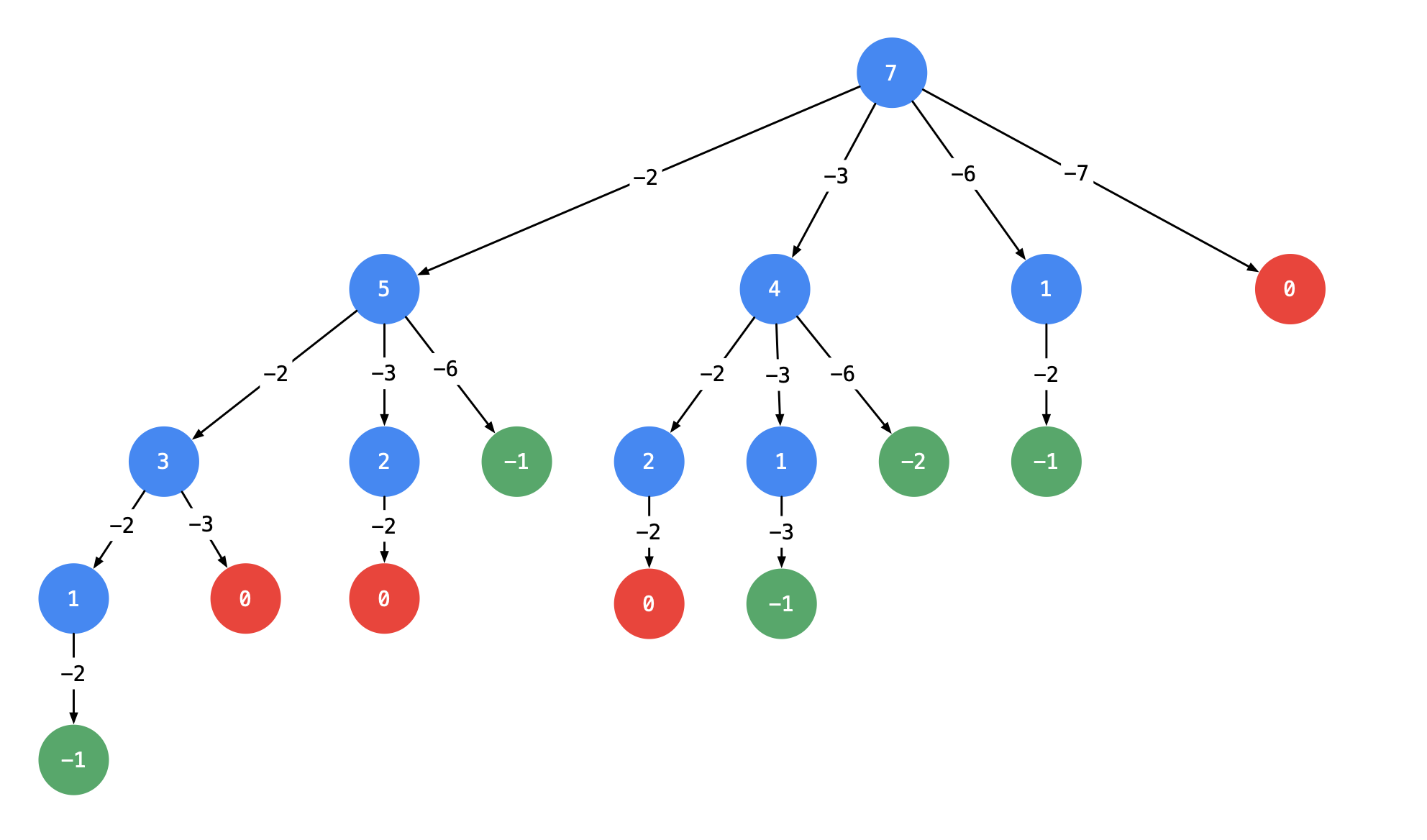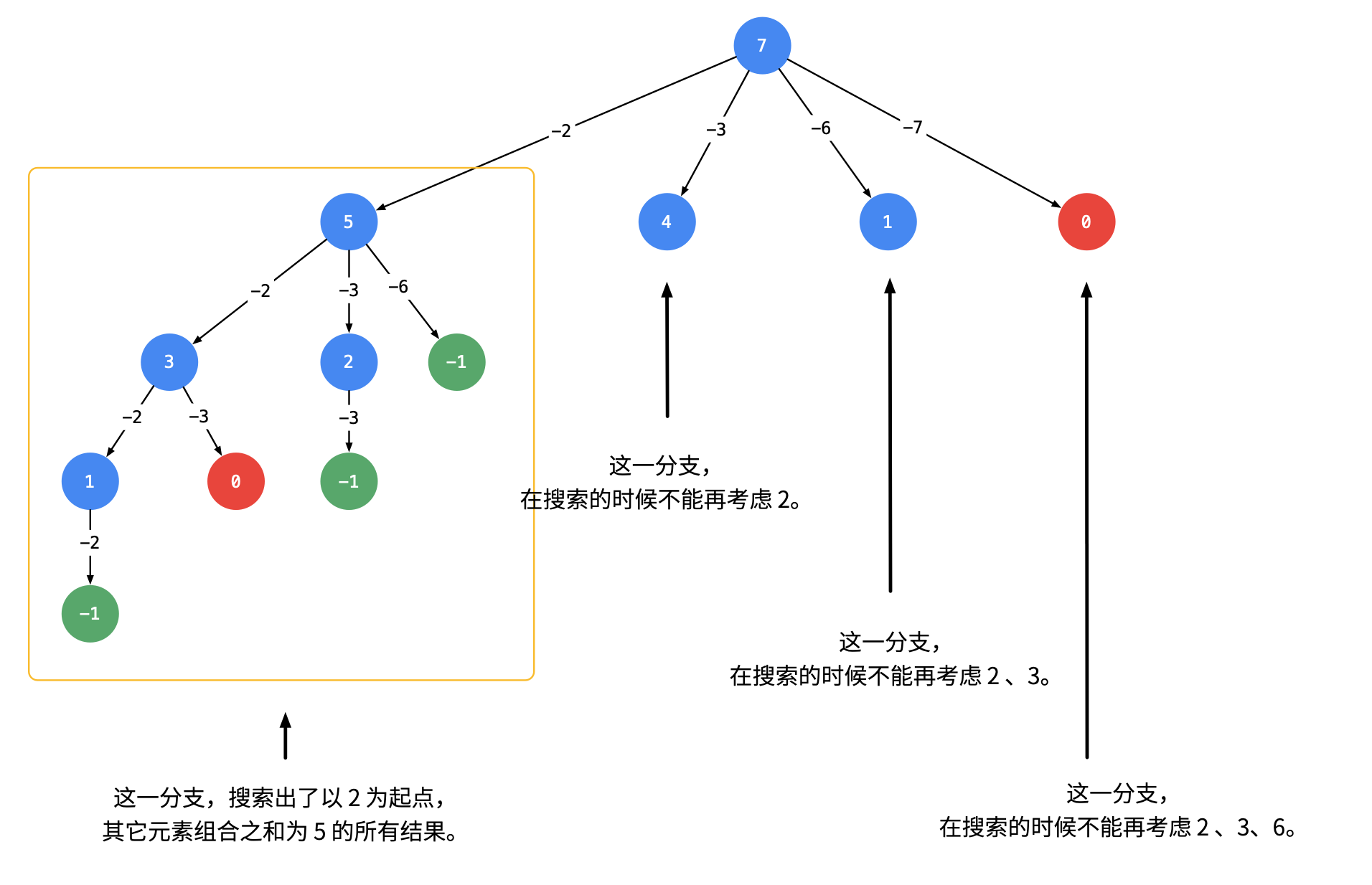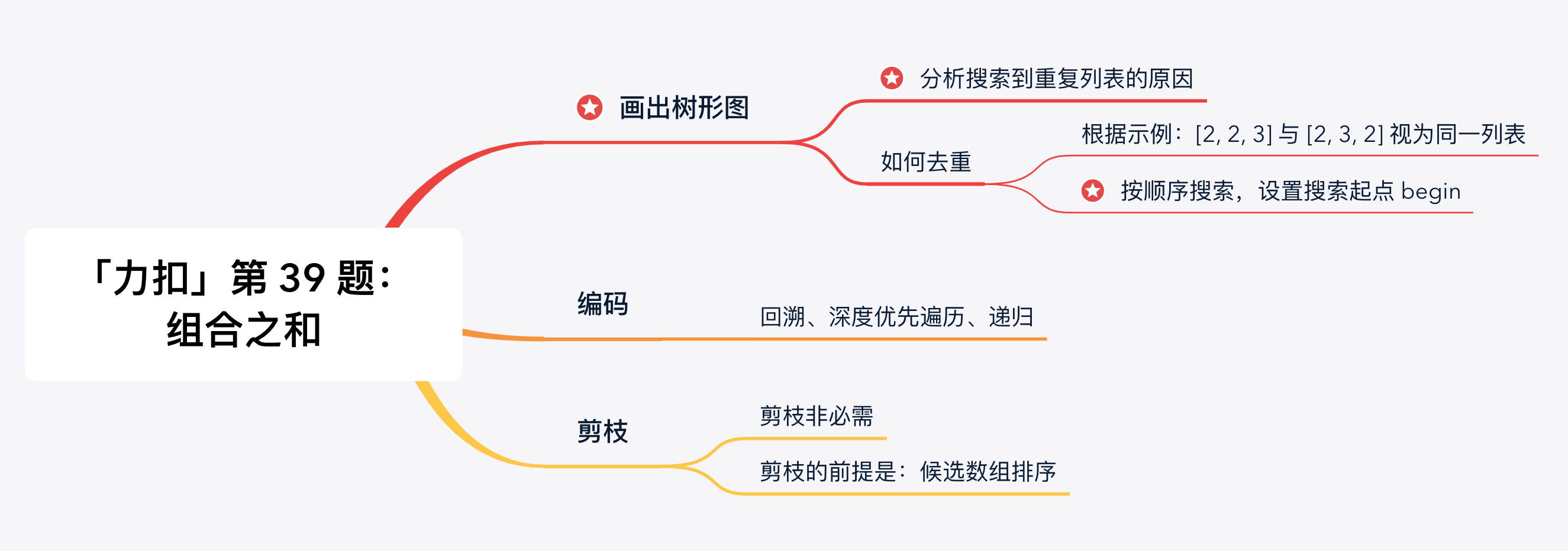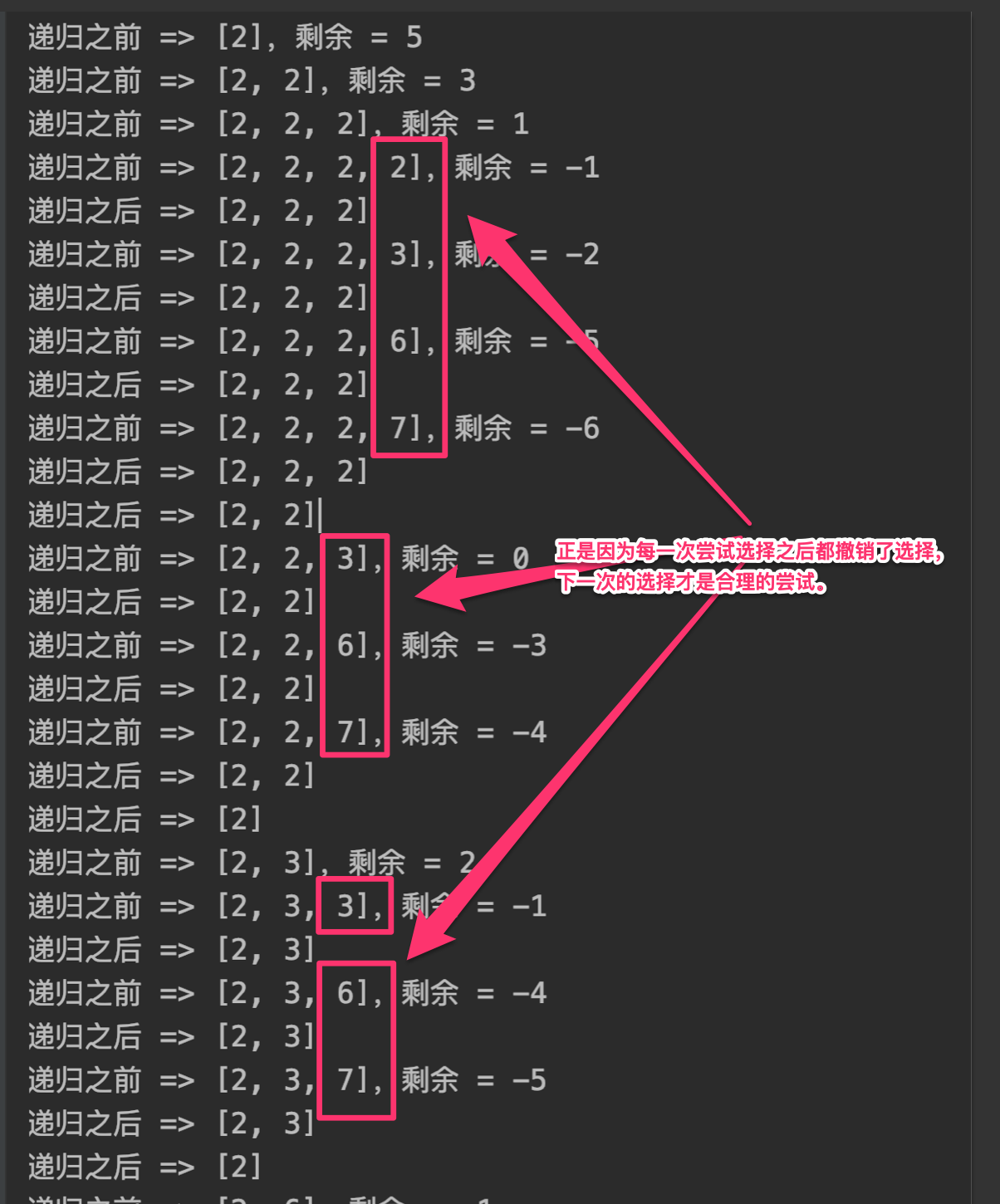给你一个 无重复元素 的整数数组 candidates 和一个目标整数 target ,找出 candidates
中可以使数字和为目标数 target 的 所有 _ _ 不同组合 ,并以列表形式返回。你可以按 任意顺序 返回这些组合。
candidates 中的 同一个 数字可以 无限制重复被选取 。如果至少一个数字的被选数量不同,则两种组合是不同的。
对于给定的输入,保证和为 target 的不同组合数少于 150 个。
示例 1:
**输入:** candidates = [2,3,6,7], target = 7
**输出:** [[2,2,3],[7]]
**解释:**
2 和 3 可以形成一组候选,2 + 2 + 3 = 7 。注意 2 可以使用多次。
7 也是一个候选, 7 = 7 。
仅有这两种组合。
示例 2:
**输入:** candidates = [2,3,5], target = 8
**输出:** [[2,2,2,2],[2,3,3],[3,5]]
示例 3:
**输入:** candidates = [2], target = 1
**输出:** []
提示:
1 <= candidates.length <= 302 <= candidates[i] <= 40candidates 的所有元素 互不相同1 <= target <= 40
思路分析:根据示例 1:输入: candidates = [2, 3, 6, 7],target = 7。
- 候选数组里有
2,如果找到了组合总和为 7 - 2 = 5 的所有组合,再在之前加上 2 ,就是 7 的所有组合;
- 同理考虑
3,如果找到了组合总和为 7 - 3 = 4 的所有组合,再在之前加上 3 ,就是 7 的所有组合,依次这样找下去。
基于以上的想法,可以画出如下的树形图。建议大家自己在纸上画出这棵树,这一类问题都需要先画出树形图,然后编码实现。
编码通过 深度优先遍历 实现,使用一个列表,在 深度优先遍历 变化的过程中,遍历所有可能的列表并判断当前列表是否符合题目的要求,成为「回溯算法」(个人理解,非形式化定义)。
回溯算法的总结我写在了「力扣」第 46 题(全排列)的题解 《回溯算法入门级详解 + 经典例题列表(持续更新) 》 中,如有需要请前往观看。
画出树形图
2020 年 9 月 9 日补充:以下给出的是一种树形图的画法。对于组合来说,还可以根据一个数选和不选画树形图,请参考 官方题解 或者 @elegant-pike 的 评论 。
以输入:candidates = [2, 3, 6, 7], target = 7 为例:
 {:width=500}
{:width=500}
{:align=center}
说明:
- 以
target = 7 为 根结点 ,创建一个分支的时 做减法 ;
- 每一个箭头表示:从父亲结点的数值减去边上的数值,得到孩子结点的数值。边的值就是题目中给出的
candidate 数组的每个元素的值;
- 减到 $0$ 或者负数的时候停止,即:结点 $0$ 和负数结点成为叶子结点;
- 所有从根结点到结点 $0$ 的路径(只能从上往下,没有回路)就是题目要找的一个结果。
这棵树有 $4$ 个叶子结点的值 $0$,对应的路径列表是 [[2, 2, 3], [2, 3, 2], [3, 2, 2], [7]],而示例中给出的输出只有 [[7], [2, 2, 3]]。即:题目中要求每一个符合要求的解是 不计算顺序 的。下面我们分析为什么会产生重复。
针对具体例子分析重复路径产生的原因(难点)
友情提示:这一部分我的描述是晦涩难懂的,建议大家先自己观察出现重复的原因,进而思考如何解决。
产生重复的原因是:在每一个结点,做减法,展开分支的时候,由于题目中说 每一个元素可以重复使用,我们考虑了 所有的 候选数,因此出现了重复的列表。
一种简单的去重方案是借助哈希表的天然去重的功能,但实际操作一下,就会发现并没有那么容易。
可不可以在搜索的时候就去重呢?答案是可以的。遇到这一类相同元素不计算顺序的问题,我们在搜索的时候就需要 按某种顺序搜索。具体的做法是:每一次搜索的时候设置 下一轮搜索的起点 begin,请看下图。
 {:width=500}
{:width=500}
{:align=center}
即:从每一层的第 $2$ 个结点开始,都不能再搜索产生同一层结点已经使用过的 candidate 里的元素。
友情提示:如果题目要求,结果集不计算顺序,此时需要按顺序搜索,才能做到不重不漏。「力扣」第 47 题( 全排列 II )、「力扣」第 15 题( 三数之和 )也使用了类似的思想,使得结果集没有重复。
参考代码 1:
补充:参考代码 1 和参考代码 2 的 Python 部分,没有严格按照回溯算法来写,这里需要了解的知识点是:
- Python3 的
[1, 2] + [3] 语法生成了新的列表,一层一层传到根结点以后,直接 res.append(path) 就可以了;
- 基本类型变量在传参的时候,是复制,因此变量值的变化在参数里体现就行,所以 Python3 的代码看起来没有「回溯」这个步骤。
[]1
2
3
4
5
6
7
8
9
10
11
12
13
14
15
16
17
18
19
20
21
22
23
24
25
26
27
28
29
30
31
32
33
34
35
36
37
38
39
40
41
42
43
44
45
46
47
48
49
| import java.util.ArrayDeque;
import java.util.ArrayList;
import java.util.Deque;
import java.util.List;
public class Solution {
public List<List<Integer>> combinationSum(int[] candidates, int target) {
int len = candidates.length;
List<List<Integer>> res = new ArrayList<>();
if (len == 0) {
return res;
}
Deque<Integer> path = new ArrayDeque<>();
dfs(candidates, 0, len, target, path, res);
return res;
}
private void dfs(int[] candidates, int begin, int len, int target, Deque<Integer> path, List<List<Integer>> res) {
if (target < 0) {
return;
}
if (target == 0) {
res.add(new ArrayList<>(path));
return;
}
for (int i = begin; i < len; i++) {
path.addLast(candidates[i]);
dfs(candidates, i, len, target - candidates[i], path, res);
path.removeLast();
}
}
}
|
[]1
2
3
4
5
6
7
8
9
10
11
12
13
14
15
16
17
18
19
20
21
22
23
| from typing import List
class Solution:
def combinationSum(self, candidates: List[int], target: int) -> List[List[int]]:
def dfs(candidates, begin, size, path, res, target):
if target < 0:
return
if target == 0:
res.append(path)
return
for index in range(begin, size):
dfs(candidates, index, size, path + [candidates[index]], res, target - candidates[index])
size = len(candidates)
if size == 0:
return []
path = []
res = []
dfs(candidates, 0, size, path, res, target)
return res
|
复杂度分析:
这个问题的复杂度分析是在我的能力之外的,这里给出我的思考。
我的结论是:时间复杂度与 candidate 数组的值有关:
- 如果
candidate 数组的值都很大,target 的值很小,那么树上的结点就比较少;
- 如果
candidate 数组的值都很小,target 的值很大,那么树上的结点就比较多。
所以时间复杂度与空间复杂度不确定。
剪枝提速
- 根据上面画树形图的经验,如果
target 减去一个数得到负数,那么减去一个更大的树依然是负数,同样搜索不到结果。基于这个想法,我们可以对输入数组进行排序,添加相关逻辑达到进一步剪枝的目的;
- 排序是为了提高搜索速度,对于解决这个问题来说非必要。但是搜索问题一般复杂度较高,能剪枝就尽量剪枝。实际工作中如果遇到两种方案拿捏不准的情况,都试一下。
参考代码 2:
[]1
2
3
4
5
6
7
8
9
10
11
12
13
14
15
16
17
18
19
20
21
22
23
24
25
26
27
28
29
30
31
32
33
34
35
36
37
38
39
40
41
| import java.util.ArrayDeque;
import java.util.ArrayList;
import java.util.Arrays;
import java.util.Deque;
import java.util.List;
public class Solution {
public List<List<Integer>> combinationSum(int[] candidates, int target) {
int len = candidates.length;
List<List<Integer>> res = new ArrayList<>();
if (len == 0) {
return res;
}
Arrays.sort(candidates);
Deque<Integer> path = new ArrayDeque<>();
dfs(candidates, 0, len, target, path, res);
return res;
}
private void dfs(int[] candidates, int begin, int len, int target, Deque<Integer> path, List<List<Integer>> res) {
if (target == 0) {
res.add(new ArrayList<>(path));
return;
}
for (int i = begin; i < len; i++) {
if (target - candidates[i] < 0) {
break;
}
path.addLast(candidates[i]);
dfs(candidates, i, len, target - candidates[i], path, res);
path.removeLast();
}
}
}
|
[]1
2
3
4
5
6
7
8
9
10
11
12
13
14
15
16
17
18
19
20
21
22
23
24
25
26
| from typing import List
class Solution:
def combinationSum(self, candidates: List[int], target: int) -> List[List[int]]:
def dfs(candidates, begin, size, path, res, target):
if target == 0:
res.append(path)
return
for index in range(begin, size):
residue = target - candidates[index]
if residue < 0:
break
dfs(candidates, index, size, path + [candidates[index]], res, residue)
size = len(candidates)
if size == 0:
return []
candidates.sort()
path = []
res = []
dfs(candidates, 0, size, path, res, target)
return res
|
总结

什么时候使用 used 数组,什么时候使用 begin 变量
有些朋友可能会疑惑什么时候使用 used 数组,什么时候使用 begin 变量。这里为大家简单总结一下:
- 排列问题,讲究顺序(即
[2, 2, 3] 与 [2, 3, 2] 视为不同列表时),需要记录哪些数字已经使用过,此时用 used 数组;
- 组合问题,不讲究顺序(即
[2, 2, 3] 与 [2, 3, 2] 视为相同列表时),需要按照某种顺序搜索,此时使用 begin 变量。
注意:具体问题应该具体分析, 理解算法的设计思想 是至关重要的,请不要死记硬背。
补充说明
如果对于「回溯算法」的理解还很模糊的朋友,建议在「递归」之前和「递归」之后,把 path 变量的值打印出来看一下,以加深对于程序执行流程的理解。
针对参考代码 1 添加打印输出:
[]1
2
3
4
5
6
7
8
9
10
11
12
13
14
15
16
17
18
19
20
21
22
23
24
25
26
27
28
29
30
31
32
33
34
35
36
37
38
39
40
41
42
43
44
45
46
47
48
49
| import java.util.ArrayDeque;
import java.util.ArrayList;
import java.util.Deque;
import java.util.List;
public class Solution {
public List<List<Integer>> combinationSum(int[] candidates, int target) {
int len = candidates.length;
List<List<Integer>> res = new ArrayList<>();
if (len == 0) {
return res;
}
Deque<Integer> path = new ArrayDeque<>();
dfs(candidates, 0, len, target, path, res);
return res;
}
private void dfs(int[] candidates, int begin, int len, int target, Deque<Integer> path, List<List<Integer>> res) {
if (target < 0) {
return;
}
if (target == 0) {
res.add(new ArrayList<>(path));
return;
}
for (int i = begin; i < len; i++) {
path.addLast(candidates[i]);
System.out.println("递归之前 => " + path + ",剩余 = " + (target - candidates[i]));
dfs(candidates, i, len, target - candidates[i], path, res);
path.removeLast();
System.out.println("递归之后 => " + path);
}
}
public static void main(String[] args) {
Solution solution = new Solution();
int[] candidates = new int[]{2, 3, 6, 7};
int target = 7;
List<List<Integer>> res = solution.combinationSum(candidates, target);
System.out.println("输出 => " + res);
}
}
|
打印输出:
1
2
3
4
5
6
7
8
9
10
11
12
13
14
15
16
17
18
19
20
21
22
23
24
25
26
27
28
29
30
31
32
33
34
35
36
37
38
39
40
41
42
43
44
45
46
47
48
49
50
51
52
53
54
55
| 递归之前 => [2],剩余 = 5
递归之前 => [2, 2],剩余 = 3
递归之前 => [2, 2, 2],剩余 = 1
递归之前 => [2, 2, 2, 2],剩余 = -1
递归之后 => [2, 2, 2]
递归之前 => [2, 2, 2, 3],剩余 = -2
递归之后 => [2, 2, 2]
递归之前 => [2, 2, 2, 6],剩余 = -5
递归之后 => [2, 2, 2]
递归之前 => [2, 2, 2, 7],剩余 = -6
递归之后 => [2, 2, 2]
递归之后 => [2, 2]
递归之前 => [2, 2, 3],剩余 = 0
递归之后 => [2, 2]
递归之前 => [2, 2, 6],剩余 = -3
递归之后 => [2, 2]
递归之前 => [2, 2, 7],剩余 = -4
递归之后 => [2, 2]
递归之后 => [2]
递归之前 => [2, 3],剩余 = 2
递归之前 => [2, 3, 3],剩余 = -1
递归之后 => [2, 3]
递归之前 => [2, 3, 6],剩余 = -4
递归之后 => [2, 3]
递归之前 => [2, 3, 7],剩余 = -5
递归之后 => [2, 3]
递归之后 => [2]
递归之前 => [2, 6],剩余 = -1
递归之后 => [2]
递归之前 => [2, 7],剩余 = -2
递归之后 => [2]
递归之后 => []
递归之前 => [3],剩余 = 4
递归之前 => [3, 3],剩余 = 1
递归之前 => [3, 3, 3],剩余 = -2
递归之后 => [3, 3]
递归之前 => [3, 3, 6],剩余 = -5
递归之后 => [3, 3]
递归之前 => [3, 3, 7],剩余 = -6
递归之后 => [3, 3]
递归之后 => [3]
递归之前 => [3, 6],剩余 = -2
递归之后 => [3]
递归之前 => [3, 7],剩余 = -3
递归之后 => [3]
递归之后 => []
递归之前 => [6],剩余 = 1
递归之前 => [6, 6],剩余 = -5
递归之后 => [6]
递归之前 => [6, 7],剩余 = -6
递归之后 => [6]
递归之后 => []
递归之前 => [7],剩余 = 0
递归之后 => []
输出 => [[2, 2, 3], [7]]
|
 {:width=”500px”}
{:width=”500px”}
针对参考代码 2 添加打印输出:
[]1
2
3
4
5
6
7
8
9
10
11
12
13
14
15
16
17
18
19
20
21
22
23
24
25
26
27
28
29
30
31
32
33
34
35
36
37
38
39
40
41
42
43
44
45
46
47
48
49
| import java.util.ArrayDeque;
import java.util.ArrayList;
import java.util.Arrays;
import java.util.Deque;
import java.util.List;
public class Solution {
public List<List<Integer>> combinationSum(int[] candidates, int target) {
int len = candidates.length;
List<List<Integer>> res = new ArrayList<>();
if (len == 0) {
return res;
}
Arrays.sort(candidates);
Deque<Integer> path = new ArrayDeque<>();
dfs(candidates, 0, len, target, path, res);
return res;
}
private void dfs(int[] candidates, int begin, int len, int target, Deque<Integer> path, List<List<Integer>> res) {
if (target == 0) {
res.add(new ArrayList<>(path));
return;
}
for (int i = begin; i < len; i++) {
if (target - candidates[i] < 0) {
break;
}
path.addLast(candidates[i]);
System.out.println("递归之前 => " + path + ",剩余 = " + (target - candidates[i]));
dfs(candidates, i, len, target - candidates[i], path, res);
path.removeLast();
System.out.println("递归之后 => " + path);
}
}
public static void main(String[] args) {
Solution solution = new Solution();
int[] candidates = new int[]{2, 3, 6, 7};
int target = 7;
List<List<Integer>> res = solution.combinationSum(candidates, target);
System.out.println("输出 => " + res);
}
}
|
打印输出:
1
2
3
4
5
6
7
8
9
10
11
12
13
14
15
16
17
18
19
| 递归之前 => [2],剩余 = 5
递归之前 => [2, 2],剩余 = 3
递归之前 => [2, 2, 2],剩余 = 1
递归之后 => [2, 2]
递归之前 => [2, 2, 3],剩余 = 0
递归之后 => [2, 2]
递归之后 => [2]
递归之前 => [2, 3],剩余 = 2
递归之后 => [2]
递归之后 => []
递归之前 => [3],剩余 = 4
递归之前 => [3, 3],剩余 = 1
递归之后 => [3]
递归之后 => []
递归之前 => [6],剩余 = 1
递归之后 => []
递归之前 => [7],剩余 = 0
递归之后 => []
输出 => [[2, 2, 3], [7]]
|
可以很清楚地看到有「剪枝」的代码考虑的路径数会更少一些。



 {:width=”500px”}
{:width=”500px”}